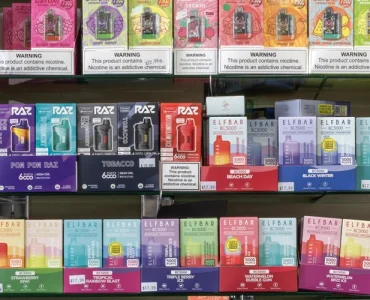Forget your plain old kanthal and stainless steel coils, ceramic coils are being touted as the next big thing that will revolutionize your vaping experience. But do they live up to the hype? And more importantly, are ceramic coils safe?
While ceramic coils may produce better flavor and provide a longer coil life when compared to traditional coils, there are concerns that it may be at the expense of your health.
- Ceramic coils have become a popular replacement for metal coils in some vape devices. Ceramic coils are thought to produce better flavor and provide a longer coil life when compared to traditional metal mesh coils.
- Some ceramic coils are wickless, like the Vaporesso CCELL coil, while others feature a ceramic case around a more traditional coil or a layer of wicking between the ceramic cylinder and the coil.
- Concerns over the safety of ceramic coils have been raised. Tests suggest that there is potential for small pieces of the ceramic coil to break during use, releasing silica powder. This could be harmful to your health.
- While they can potentially provide many benefits to vapers, such as lasting longer and producing better flavor, safety concerns mean that ceramic coils are unlikely to replace metal coils in mainstream vapes.
What Are Ceramic Coils?
What do clay, bricks, tiles, glass, and porcelain dentures have in common? They’re all example of ceramics, of course! Ceramics are a common material that we encounter all the time in our day to day lives, and are a wondrous material for their hardness, ability to withstand extremely high temperatures, and resistance to erosion.
In coils made with ceramics, there are a couple of different designs. Perhaps the most well known is Vaporesso’s CCELL ceramic coils, which are coils encased in a ceramic cylinder. This design is completely wickless, as the microporous nature of the ceramic allows the ejuice to flow freely to the coil. This produces a better flavor, longer coil life, no chance of a dry hit due to the absence of cotton, and will potentially allow you to use less juice due to the great heating abilities of the ceramic.
Additionally, there are also ceramic coils that are similar to your regular coils in appearance, but they are coated and encased in ceramic. These coils are still wicked with cotton but this ceramic coating prevents further oxidation of the metal which could lead to metallics in your vapor.
Lastly, while less common there are also ceramic coils where there is a layer of cotton in between the coil and the ceramic cylinder. This design is much more brittle and fragile, and has a higher chance of breaking if not handled carefully.
Are Ceramic Coils Safe?
While ceramic coils are being touted as the answer to all of the problems that vapers are currently facing with their coils, they may just be replacing our current problems with new, far more dangerous ones.
In an objective research and analysis of how ceramic coils affect vapers health, Uwell used a microscope to examine three different ceramic coils and their microstructures and powder size. What they discovered is that there is potential for small pieces of the ceramic coil to break and release silica powder, which is harmful to your health. Prolonged inhalation as done in vaping can lead to trachea and lung damage, as well as lung cancer.
When examined under a microscope, ceramic coils reveal many impurities and the glass like particles are uneven, chaotic, and sharp.

If scratched, jolted, dropped, or vibrated with enough force, there is the potential for the ceramic coil to shed silica powder which is very harmful to your health. This powder is composed of tiny, sharp, glass like crystals that are too tiny to see with the naked eye. If inhaled, the possibility of trachea and lung damage is very real.

And if you’re sitting there thinking: “But if i’m extremely careful and never drop or scratch my ceramic coil, i’ll be safe!” Think again.
Uwell points out that because of the manufacturing process, silica powder is produced after taking the coil off of the mold. This dust is quite sticky and will stick to the inside of the ceramic coil. There is ceramic powder on the inside of every ceramic coil on the market and because of the high air speeds going through your tank while vaping (up to 223mph), there is a high potential for this dust to be introduced into your lungs.
Potential Health Complications from Inhaling Silica Dust
- Silicosis: a form of occupational lung disease caused by inhalation of crystalline silica dust.
- Lung damage
- Difficulty breathing
- Scarring of the trachea
- Lung cancer
The bottom line
While they can potentially provide many benefits to vapers, ceramic coils just don’t seem to be worth the risk. Because of the potential for pieces of the ceramic to break and produce silica dust that is hazardous to health, we don’t recommend using ceramic coils.
Even the smallest scratch, drop, or vibration can release this dust and it is definitely present in all ceramic coils due to the manufacturing process. It’s better to be safe than sorry, and your health is no joke. I would rather have a longer life span myself than a longer life span for my coils, wouldn’t you?











Hi Adam,
thanks for a very interesting write-up!
So which coil would you prefer for safe vaping? Are RDTA tanks with organic cotton safe? Please let me know your thoughts.
Hello Krishna,
Glad you enjoyed it! I personally prefer kanthal or stainless steel. An RDTA with organic cotton is perfectly fine, no need to worry.
Vape on!
I have a ceramic coil atomizer and I think what you are saying sounds to me like you are trying to scare people. The air holes aren’t big enough to allow the air speeds you speak of here.
With oil or e juice in the tank dust particles should get trapped by the oil. in
Hello Steve,
The air speeds I quoted are taken directly from the article on the study done by Uwell. As for the ejuice trapping the particles, that ejuice is what you’re vaping so it’s making its way to your lungs. I myself wouldn’t trust the ejuice to trap all of the particles.
What are the “healthiest” coils that don’t leech out heavy metals or silica? When under fire.. Are there any out there?
Kanthal, SS316L, Ni80, nickel and titanium coils are all perfectly safe when used and maintained correctly. The only time these materials will leech out heavy metal would be if they’re overused and start to degrade (when they aren’t replaced after heavy use), or if used at wattages way beyond what a human can stand. The studies you may have seen that found heavy metals in vapor were done by burning the coils until they vaporized the cotton and heated up the coils to levels that no vaper could bare. You’re safe with these five materials.
What a load of nonsense! The “research” on ceramic coils that you are mentioning here is not real research. There is no concrete evidence as of now (2019) that ceramic coils are more unhealthy than regular coils. In fact, ceramics are getting more and more popular, especially in the cannabis industry where ceramic CCELL cartridge have become the norm.
Uwells scratch-off “study” / FUD had been debunked already:
https://greenlotushemp.com/2019/07/24/green-lotus-vape-carts-use-ceramic-coils/
→ Unnamed Vape Brand Says Ceramic Coils Are Dangerous. Now, They Sell Ceramic Coils.
http://www.tasteyourjuice.com/wordpress/archives/10103
→ No particulate matter found on testing filter.
http://translate.google.com/translate?hl=&sl=de&tl=en&u=http%3A%2F%2Fnebelkraehe.eu%2F2017%2F01%2F%EF%BB%BFglueck-auf-keramik-im-verdampfer%2F
→ Atomizers aren’t coal mines.
Hello Mario,
Thanks for the links. I checked them out and while the filter testing looks good, that’s just one isolated test.
In regards to the first link to Green Lotus Hemp: is it really any surprise that a company that sells ceramic cartridges would be trying to defend them? There’s no proof of any sort to back up their claims there either. It reads more like a promotional article for their product than anything else.
Plus, they say that Uwell now sells ceramic coils — where? I’ve searched on popular vape retailers websites as well as on Uwells own and can’t seem to find a ceramic coil that they sell. If I’m wrong and just missed it, please correct me. If someone can link me to Uwells ceramic coils I’d love to take a look.
As of now, I haven’t come across any concrete, scientific mass testing on ceramic coils to make me believe that they’re safe. What Uwell are saying in their tests makes logical sense when you take into account how brittle ceramics can be.
Even if you don’t trust Uwell, Vaporesso who are another large vaping company state this in their blog about ceramic coils: “Ultimately, the studies are inconclusive, but the worst-case scenario is that long-term vaping with ceramic coils may pose a severe health risk.”
I, personally, would rather not risk it.
Im using vaporesso Podstick ccell…..and whenever i need to change it ….i change the cartridge not the ceramic….is this way safe and far away from sillica powder?
after reading this i thought i had ceramic particulate in my throat. i was coughing and gagging and fearing for my life.
then i realized it was left over from my breakfast and i hadn’t brushed my teeth. he he he (true story)
Hi! what vaporizer is good then? most of the popular have ceramic coils, like mighty,volcano etc.
Hey David. Those dry herb vaporizers that you mentioned use ceramic bowls, which is different from ceramic coils used in nicotine vapes. I think the danger lies in ceramic coils that are manufactured to wick and absorb ejuice, as those coils typically sit in the center or ‘inside’ of the tank.
These ceramic coils typically also sit inside of a metal tube which functions as the path for the airway. This manufacturing process and placement is what can potentially introduce ceramic dust.
The ceramic bowls used in dry herb vapes should be fine, as they aren’t contacting any liquid and they sit ‘outside’ and around your dry herb material.
All of this is, of course, my own personal opinion based on what I’ve read on the subject.